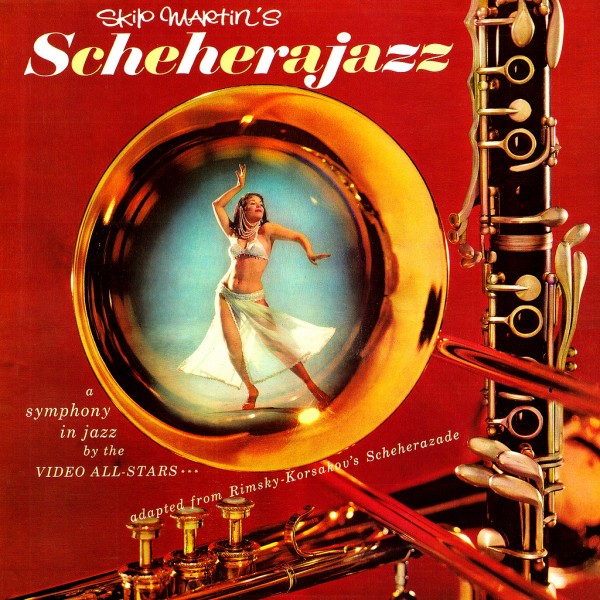
SKIP MARTIN
Scheherajazz
Somerset Records, 1959 (Reissued 2009 on Flare)
When you have friends over for a barbecue, it’s good to have some albums set aside that are gems from beginning to end. It puts everybody in that food mood. Skip Martin’s Scheherajazz is one such record. Martin was a jazz musician and arranger who worked with most of the big bands from the late ’30s through the early ’60s and was chief muckety-muck of several legendary recordings. At the end of the ’50s, Martin brought together a band of top-notch studio musicians under the name The Video All-Stars. Working with Dave Miller’s Philadelphia-based Somerset Records, he arranged and produced some pretty crazy jazz novelty LPs that have a deliberate kookiness you might see on Jack Lemon’s face when he’s playing The Zodiac Club in Bell, Book & Candle. Rimsky-Korsakov’s much beloved Scheherazade is one of those giant thematic classical masterpieces that you know even if you think you don’t. Lilting and pleasant then loud and bombastic in recurring circles throughout all the movements, it’s as much an inevitable part of our culture as Wagner’s Flight of the Valkyrie or Rossini’s William Tell Overture. The Video All-Stars play a straight up and charming arrangement of Scheherazade, which reels you in like comfort food, but then every few minutes bursts into a wild post-war big band break that really swings. They cover each of the movements so reverently while in classical mode, then drive that big band buggy right off the cliff, again and again. The production shifts so wildly from calm to crazyville (and you can hear it coming) that it never fails to bring roars of laughter mixed with looks of puzzlement and awe from guests. So right, while still being so, so utterly wrong. –TODD KIMMELL
*
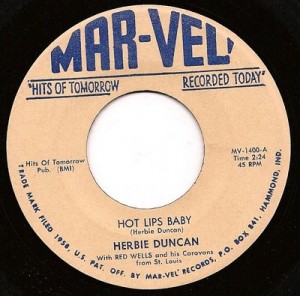 HERBIE DUNCAN
HERBIE DUNCAN
Hot Lips Baby/My Little Angel
Mar-Vel Records, 1958
Herbie Duncan contributed two unforgettable rockabilly train wrecks to mid-20th Century America. I write that with affection. Bit by the Elvis bug, in 1958 he cut “My Little Angel,” where he croons/rocks about the object of his desire in a wavering, inarticulate style that sounds like the King channeling Tiny Tim. Backed by a chintzy band on autopilot disengaged from Duncan’s passion and cliched lyrics, the song is unforgettable, and the “bop bop bop bop bop bop a buh boo” at the end sends the song into the stratosphere. “Hot Lips Baby” is in trouble from the get-go and yet is totally captivating. “Oh oh oh baby,” Duncan writhes, “you are oh oh oh so mean”, then “so keen.” His heart just flips from “a-kissing her hot lips.” Duncan’s last vestiges of self-control succumb to 100% pure babbling enthusiasm and lust. His final raspy vocals veer way off key but, dammit, he’s singing straight from his groin and rocking like nobody’s business. Thing is, you don’t laugh but break into a big smile. Herbie was undeniably inspired, he wanted to be famous, surely he wanted to get laid, he HAD to rock and, talent be damned, he got into the studio. And despite an obvious lack of talent, his enthusiasm was not in the least watered down. We should all have the heart and panache of the incredible Herbie Duncan. –BRIAN GORDON
*
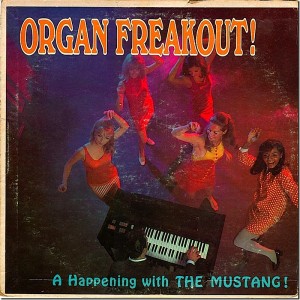 THE MUSTANG
THE MUSTANG
Organ Freakout! (A Happening with the Mustang!)
Somerset, 1968 (Bargain bin division of the Alshire label)
The liner notes of this misguided cult LP tell you everything you need to know: “When the Mustang mounts the Hammond – and the “Amps” start cookin’ – look out baby – it’s an organ freakout. All the same artistry and down home abandon of Frisco ‘67 comes screaming out of the speakers. Call it Soul, call it electronic soul, HERE’S WHERE ITS HAPPENING.” Rumors have been flying about this truly dunderheaded take on psychedelia for years: Folks say the Mustang was actually Billy Preston slumming because he needed cash. There’s talk that one of the dancers on the cover is a very young Terri Garr, who was an actual go-go dancer in 1968. It’s been pointed out that the organ on the cover isn’t a Hammond at all, but rather an uncool Lowry. And just where is the Mustang’s left hand? In reality, the perpetrator of such hippie gems as “Golden Gate Freakout,” “Joshua Got Busted,” and “Tennessee Waltz Frug” is a well-respected studio musician named Paul Griffin, who played piano on LP’s by Bob Dylan, Steely Dan, the 101 Strings, as well as Don McLean’s classic radio staple “American Pie.” No word on how he got tangled up in this project, but the actual music seems closer to something you’d hear at Don Draper’s hot new digs rather than Haight Ashbury back in the day. There are plenty of copies of this chestnut on eBay, and there’s rumor of a 12″ remix. Organ Freakout is also available on iTunes. –BILL AMUNDSON
*
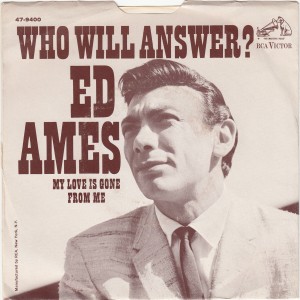 ED AMES
ED AMES
Who Will Answer?
RCA, 1968 (Reissued 1997)
Like so many other crooners in the late ‘60s, singer/actor Ed Ames (who’d had a hit with “My Cup Runneth Over” but was better known for his role on the Daniel Boone TV series) attempted to tap into the youth market by releasing an album of songs by then-popular acts like Dylan, The Mamas & Papas, and The Monkees. Most such efforts were just embarrassing, but Who Will Answer? is surprisingly good, and Ames’ deep baritone was never in better form. What sets the album apart is the opening title track. It introduces an album aimed at hippies with an epic, piece-by-piece dismantling of the emptiness and nihilism of that lifestyle. Beyond that, it’s also a great, majestic, and surprisingly contemporary song which, in a strange way, almost presages “Bohemian Rhapsody” with its shifting styles, background choirs, and soaring vocals. Here’s a sample lyric: High upon a lonely ledge, a figure teeters near the edge, And jeering crowds collect below, To egg him on with, “Go, man, go!” But who will ask what led him, To his private day of doom, And who will answer? After Ames demolishes the counterculture, “Blowin’ in the Wind” doesn’t seem nearly as profound. “Who Will Answer?” was also released as a single and reached No. 6 on the Billboard Adult Contemporary chart and 19 on Billboard’s Hot 100. — JIM KNIPFEL
*
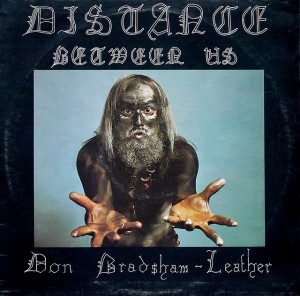 DON BRADSHAW-LEATHER
DON BRADSHAW-LEATHER
Distance Between Us
Distance Records, 1972
Don Bradshaw-Leather’s self-released double LP, Distance Between Us, is without question one of the most definitively obscure and elusive records on the planet. And why not? Seriously, look at this thing. On the cover is some bearded freak covered entirely in black makeup. Is he meant to be an evil Pict? A necromancer? Beelzebub? And on the back there’s our hero again, centered with a topless damsel, while a crude mandalic menagerie of smaller snaps surround them. No text, but if a picture is worth a thousand words, obviously Don Bradshaw-Leather knew how to parry with a pound. Surely, this must have seemed luridly incomprehensible to the general record buying public of early 70’s Britain. Such randy, Satanic bollocks! But then who would have seen it? Pressed in a miniscule edition, this thing is as rare as hen’s teeth and just as bizarre. Musically, one might expect this to be something akin to The Crazy World of Arthur Brown but not so. Oddly (or not), it’s more reminiscent of classical than rock music. Comprising four sprawling side-long pieces, Distance Between Us features the mellotron, keys, and a pounding, rhythmic percussion that give it an overall vibe of a deranged Scriabin protégé in the throes of a Saint Vitus Dance. Shambolic yet symphonic, it’s a beguiling artifact any way you slice it. Original copies sell for upwards of $500, and while the idea of a reissue has been bandied around for a few years, it’s yet to see the light of day. No matter, those curious can listen to Distance Between Us on Youtube. –T.J. LAX
*
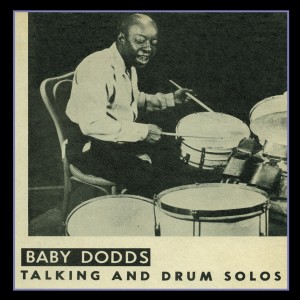 BABY DODDS
BABY DODDS
Talking And Drum Solos
Folkways/Atavistic, 1946 (Reissued 2003)
Trained originally in marching bands, Warren “Baby” Dodds met Louis Armstrong on the Mississippi riverboat circuit in 1918, while playing up and down the river as well as in port in New Orleans. Dodds (the brother of Woody Allen idol, clarinetist Johnny Dodds) was in Armstrong’s seminal Hot Sevens Band and helped set the rhythm of the century’s new music, “Jazz.” In 1945, Folkways Records took him in the studio to make an unprecedented stab at catching Dodd’s unfathomable drum technique. On his goat skin drums and a small collection of wood blocks and cowbells, Dodd demonstrates what he could do, showing off tricks he called “bumble tumble,” “biffs,” and “nerve beats.” In the early days, primitive recording technologies demanded that Dodds hold back, but here he lets loose and sounds as if he’s from another world. Like an over-driven stream-powered machine, Dodd’s kit erupts into a hyperactive succession of intricately-timed rattles, rings, and low-end thumps that swing with the jittery energy of the most experimental hip-hop backing tracks. In a time when drums were still thought to have a supporting role in music, this recording shows that Dodd’s drumming was not just the pulse but the root of a musical revolution. –DAN BUSKIRK
*
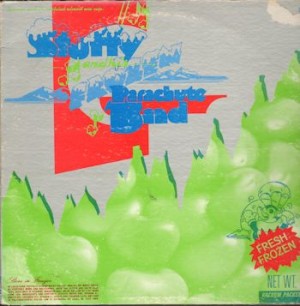 STUFFY
STUFFY
Stuffy and his Frozen Parachute Band
Paramount Records, 1974
“Tired of canned music??? FROZEN MUSIC CAN CHANGE YOUR LIFE!!” proclaims Stuffy on the back cover of his only known release, 1974’s Stuffy and his Frozen Parachute Band. I doubt you’ll find this rare gem anywhere today. Stuffy puts forth a collection of psychedelic folk rock tunes layered with big acoustic rhythms, slide guitars, banjos, bongos, pedal steel, and lush strings that give a nod to many of the styles and artists that preceded him in the genre.
The strutting blues tune “Everybody Hopes You’re Mine” with its double-track fiddle is reminiscent of Papa John Creech in the Hot Tuna days, and “Space Ranger” hearkens back to the Byrds “Eight Miles High.” Stuffy entertains with music that’s kept cool “by a special freezing process called reverse mystical entropy-loss.” He educates us about groupies in “Just Another Jesus” and feeds us a little cocksure rock star blues in “Captain Jack and the Factory Man.” No other musicians are credited, but there are some female background vocals, and I doubt Stuffys’ playing the one man band. Somewhere, somehow, Stuffy deserves his place in the rock and roll lexicon. –DAVE CORBO
*
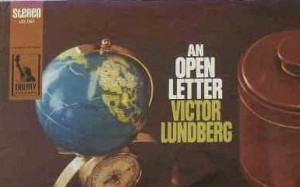 VICTOR LUNBERG
VICTOR LUNBERG
An Open Letter to My Teenage Son
Liberty, 1967
In 1967, a Grand Rapids AM newscaster was mad as hell at those long-haired kids and wasn’t going to take it anymore. So he recorded a rant titled “An Open Letter to My Teenage Son” and released it on a 45. Over a turgid rendition of “The Battle Hymn of the Republic,” the stern, no-nonsense voice of Victor Lundburg began listing everything that today’s youth was doing wrong for four long, unforgiving minutes. Finally, after assuring his son that he will always love him, he ends his missive with a warning that if Junior decides to burn his draft card, he might as well burn his birth certificate too, because “from that moment on, I have no son.” “An Open Letter” became a local hit, before being picked up for a national rollout by Liberty Records, home of the Chipmunks, on Armistice Day. It sold a quarter of a million copies in the first two days, the perfect example of a “45-ripped-from-the headlines.” And like any good novelty record, it spawned a lot of others trying to ride its wake. Oh, what I would give to hear a copy of “A Letter to Dad” by Every Father’s Teenage Son or “A Teenager’s Answer” by Keith Gordon. An LP followed, but by Christmas the 45 had spun for the last time on Billboard’s Top 40, quickly becoming just auditory junk mail, return address unknown.
Available on the compilation, Next Stop is Vietnam (Bear Family Records), and as a download on Amazon. –GEO STEWART
*
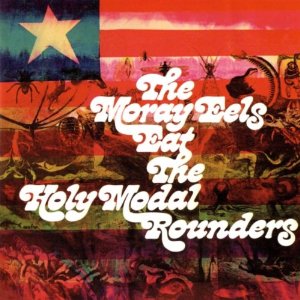 THE HOLY MODAL ROUNDERS
THE HOLY MODAL ROUNDERS
The Moray Eels Eat the Holy Modal Rounders
Elektra Records, 1968 (Reissued 2002 on Water Records)
The Holy Modal Rounders were a ’60s folk duo, made up of Peter Stampfel (vocals, fiddle, and banjo) and Steve Weber (vocals and guitar). They performed in a manic style that was often downright hysterical, exploring old time mountain music and blues. Inspired by drugs, they could stretch those styles into exuberant, absurd, gonzo music. One of their primary sources was Charlie Poole, a well-known North Carolina singer in the ’20s. Stampfel channeled Poole’s vocals so assiduously, he sounded like vocals from a scratchy old 78. As folk drifted to rock in the mid-60s, the Holy Modal Rounders broke up, they joined the Fugs for a short time, and then Stampfel formed a new group called The Moray Eels. But then the Rounders were offered a deal with Elektra. Stampfel agreed with stipulation that the Moray Eels be part of the deal. Thus came The Moray Eels Eat the Holy Modal Rounders in 1968, a moment of singular insanity. The music is a hopped-up hyper version of the Rounders’ earlier style with the addition of piano, drums, and electric guitar. It has a speed-laced psychedelic edge, and the lyrics deal with drugs to an unprecedented extreme. The record has no separate tracks with songs colliding into one another. It’s best appreciated in an enhanced state. You might wonder what amount and combination of drugs created this 30-minute hallucinatory experience. Answers: As much as possible, and all of them. –PETER STONE BROWN
*
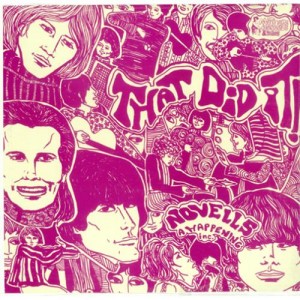 THE NOVELLS
THE NOVELLS
That Did It!
Mother Records, 1969
The San Fernando, CA-based Novells released That Did It! in 1969 on the now-defunct Mother’s Records (not to be confused with U2’s pet project of a similar name), and that seemed to do it (har har) for their career. Pandora, the internet radio outfit, began playing a handful of tracks from a probably-illegal Radioactive reissue in 2005, and even if it’s 40 years late, appreciation of That Did It! has grown, and it’s not entirely misplaced—the album is pretty good. The band chugs through the psychedelic playbook, from the mellow simplicity of “Age of Innocence” (my favorite track) to freewheeling crunch in “Pink Wallpaper” and “Tomorrow’s Yesterday.” They also find time to convincingly cover Lee Michaels, Otis Redding, and Cream, though only “Sitting on the Dock of the Bay” is strong enough to warrant the B-side it never got. Your mileage may vary with vocalist Bob Archer’s compressed, nasaly whine, and “Almost There” is hard to appreciate as anything other than a flat attempt at a counterculture anthem—but any fan of psychedelia will appreciate what is overall a well-read foray into the genre. –BEN BREUNINGER
*
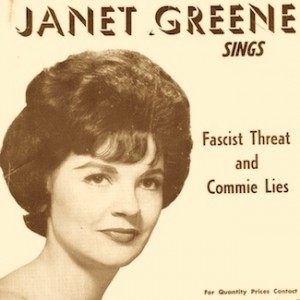 JANET GREENE
JANET GREENE
Fascist Threat/Commie Lies/Poor Left Winger
Chantico Records, 1966
While Joan Baez reigned as the Queen of Folk, an Orange County John Birch-related label counteracted with right-wing folkie Janet Greene, who made a few 45s based on paranoia of a communist takeover. She recorded ditties like “Fascist Threat,” a bouncy number where she lectures us on how fascism and communism are one and the same. “Commie Lies”, sung to the tune of “Blue Tail Fly,” warns us of impending centralization and the theft of our freedoms. It wouldn’t be too out of place at a Tea Party rally today. These two catchy sing-along numbers, however, don’t prepare us for her masterpiece, “Poor Left Winger,” in which she sings from the point of view of a poor young girl under the spell of a bearded singer “twanging a plaintive folk song spreading the Communist word” at the local coffeehouse. Tragically, this naïve young lady is left in the gutter because she believes the hippie’s evil rhetoric. The fear, anger, and sarcasm in this song reflect the concerns of (then) far-right Americans. Lots of patriotic/right-wing 45s were cut back in the day, sung (or recited) by middle-aged men with orchestral backing. Greene’s releases remain especially memorable for her voice, style, and sincerity. It’s not a stretch to imagine her singing “The Times They Are A-Changin’” in Washington Square, though likely in a different context. –BRIAN GORDON
*
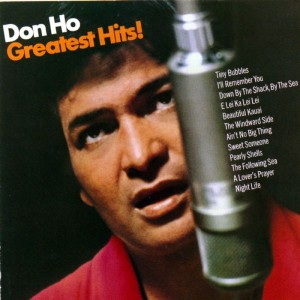 DON HO
DON HO
Greatest Hits
Reprise, 1969 (Reissued 1990)
In this smug age, Don Ho has been reduced to little more than a punch line, a one-hit novelty pop crooner who entertained aging tourists. But his Greatest Hits, which is his top selling CD, puts the lie to that—he was in reality a wide-ranging singer with a smooth, deep, romantic voice. And as the live tracks on this disk show, he was a hugely entertaining performer and, if you listen carefully, a very strange one. As many times as I’ve heard it, a number of the tracks still leave me scratching my head in wonder and confusion. For one thing, he has a tendency to slip from English to Hawaiian in the middle of a line, leaving you wondering just what the hell happened to the surfboard he was singing about. It’s not just Ho, either. In the call-and-response “Pearly Shells,” the audience echoes whatever Ho sings in the first verse. But then in the second verse he switches to Hawaiian, and the audience—supposedly a group of fat drunken Americans—responds in Hawaiian. But instead of echoing what he just said, they respond with a different line in Hawaiian. How do they know these things? It’s questions like that that keep me up at night. –JIM KNIPFEL
*
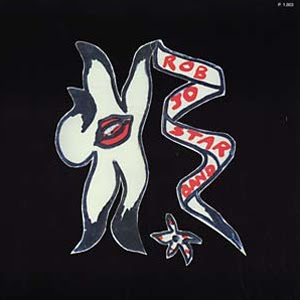 ROB JO STAR BAND
ROB JO STAR BAND
s/t
Dom Records, 1973 or ‘75
Rob Jo Star Band’s s/t one shot is a masterpiece of sublime rock blurt, originally seeing the light of day in either 1973 (or ’75) on the tiny French label, Dom. First, you’ve got a cover that is incomprehensibly alluring in its primitiveness. What’s going on, fellas? And then you hear it. Could any other record so perfectly fuse the Velvet Underground, the Thirteenth Floor Elevators, and Hawkwind? Surely not! The vocalist sounds like he’s cramming skewers of fondue down his gullet as he garbles the lyrics en anglais. Everything seems hurried and frantic, as if it were recorded live. This also adds to the charm, but makes you wonder if perhaps Rob Jo Star’s LP was recorded on someone else’s dime. One of the oldest tricks in the book: major label band rents out huge blocks of studio time, and while they slumber in the arms of Morpheus, the studio engineer brings in his friends to record, gratis. It’s a lovely thought anyway. This was recently reissued on the Pomme label, which is great, since originals in the most battered condition command as much as $300. Definitely worth tracking down if your game is proto punk or greasy psych rock. –TJ LAX
*
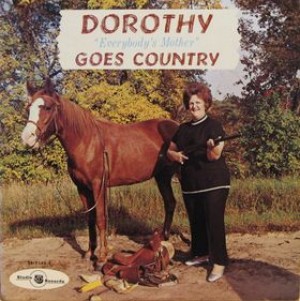 DOROTHY FREYBERGER
DOROTHY FREYBERGER
Dorothy “Everybody’s Mother” Goes Country
Studio 5 Recordings, late ’60s
This LP by the self-described “Mother of us all” is all over the musical board, from covers of “Harper Valley PTA” and “When the Saints Go Marching In” to originals like “Big Momma” and the unforgettable “Big Fat Gal.” Dorothy performed at Elks Clubs and Rotary meetings throughout the Midwest, and was a staple for years at the Minnesota State Fair. For a time this proto-feminist even had her own fan club. But it’s the cover art that truly distinguishes this album from it’s glossy Nashville counterparts. It also raises lots of questions: Is that her gun? Is the black ensemble a riding getup? What’s with the silver shoes? And what is all that junk sitting on the ground near the saddle? Apparently, everyone knew that Dorothy had no intention of actually mounting the horse, but couldn’t they’ve put the saddle on for a sense of aesthetic decency? Dorothy Freyberger passed away in 2010 and is sorely missed by her family, according to the Facebook page dedicated to her honor. I’ve yet to find any hard evidence of any other recorded vinyl by Freyberger, so this classic may be her sole legacy. –BILL AMUNDSON
*
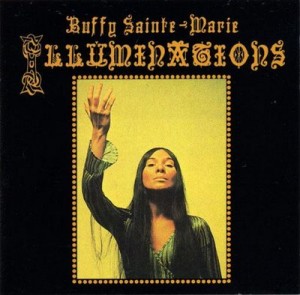 BUFFY SAINTE-MARIE
BUFFY SAINTE-MARIE
Illuminations
Vanguard, 1970 (reissued 2006)
Buffy Sainte-Marie’s Illuminations is one of those records that you want to play for friends–to be unwrapped, tasted and savored. The places this LP takes you are … unexpected. In the 1960s, Buffy Sainte-Marie, along with Dylan and Baez, defined the term ‘protest singer.’ She wrote masterpieces like “My Country Tis Of Thy People You’re Dying,” an unmerciful eye opener delivered like so many crushing body blows, yet she was flexible enough to write the raw and simple emotion of a jilted lover in “Take My Hand For Awhile” and the joyous country anthem “Piney Woods Hills,” still a standard of the Grand Ol’ Opry. In 1969 the music world was very psychedelic and electronic. Instead of sidestepping the direction of the moment, on Illuminations she embraced it. The results, with a few exceptions that haven’t weathered the test of time, run from interesting and good to HOLY SHIT, WHERE THE HELL DID THAT COME FROM? The opening number needs to be heard with the volume way up and the lights way down. “God Is Alive, Magic Is Afoot” is a Leonard Cohen poem put to folk guitar, synthesizers, and Buffy’s vocals. The results are a goddamn unique experience that worked then and still shocks today in its fully committed delivery. “Poppies” and “The Vampire” are solid psych. “The Angel” is one of those songs that should be remixed into a giant thumpa thumpa 90s Euro electro disco dance hit. “The Dream Tree” and “Guess Who I Saw in Paris” are lilting, swirling folk gems. For me the bookend to the bizarreness of “God Is Alive” is “Suffer the Little Children,” a folk punk number is not pretty but pulls no punches. The lyrics and the slashing acoustic guitar kick the chair right out from under you. I’m sure the producers considered how far out on a limb, panting, this song leaves you when they mercifully decided to segue right into the beautiful, melodic melancholy of “The Angel.” — TODD KIMMELL
*
ABOUT THE AUTHORS: Geo. Stewart is the host of Crazy College, a radio program dedicate to “all musics odd, silly or forgotten.” It can currently be heard every Sunday night at 6pm on FM 91.3, WVUD; Todd Kimmell is an entrepreneur, historian, curator, film presenter, charity auctioneer, impresario, wiseacre, and occasionally … performer. Kimmell’s studio and business, The Grand Review, is housed in a 100-year-old bowling alley in Ardmore. And yes, the goddamn bowling alley is up and running; TJ Lax is the mastermind behind Silt Breeze Records; Peter Stone Brown is a singer-songwriter and freelance writer. You can find out more about him at www.peterstonebrown.com; Ben Breuninger is the guitar player for the Big-Eyed Bees, a roots-rock outfit from Oxford, Pa. He studies literature at Dickinson College, where he also hosts a weekly radio show. Thanks to Mike Walsh for curating and compiling this list. You can check out more of his work at missionCREEP.
